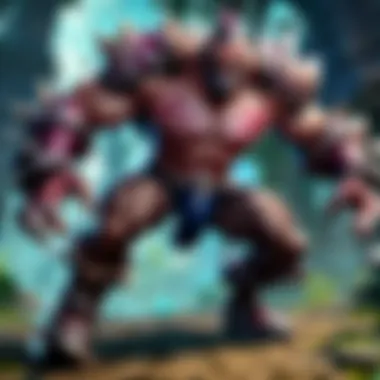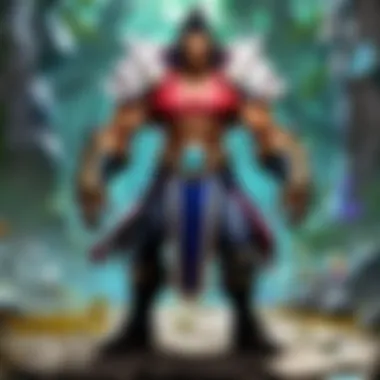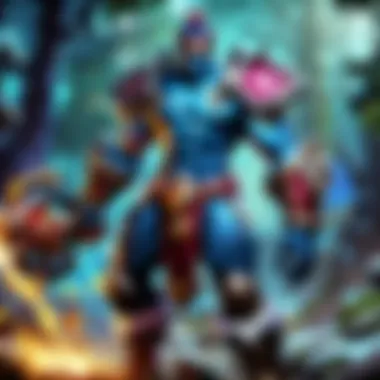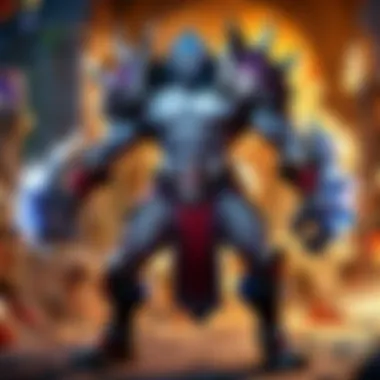A Comprehensive Guide to League of Legends Gameplay


Intro
League of Legends, a titan in the gaming industry, isn’t just a game—it’s a phenomenon. Launched in 2009, this multiplayer online battle arena (MOBA) has entangled millions of players globally into its vibrant world. The game combines fast-paced strategy with individual skill, a balance that keeps players returning. The allure lies not only in the gameplay itself but also in the community it cultivates.
Navigating the complexities of League of Legends can feel like trying to read a map in a foreign land. Each champion offers different abilities, strategies, and styles, making the game rich yet challenging. This article aims to lift the veil a little, providing insights into gameplay dynamics, champion analysis, always-evolving meta, and the plethora of community interactions that complement the competitive edge of this dynamic universe.
Key Points to Discuss:
- Champion roles, builds, and strategies to optimize performance
- Early game tactics to secure an advantage right from the start
- The latest patch updates and how they influence the competitive landscape
- Updates in esports events that shape the pro scene
- Communal interactions, including fan initiatives and creative expressions inspired by the game
Ultimately, whether you're just starting or a seasoned player looking to refine your skills, this guide serves as a cornerstone in understanding the enduring appeal of League of Legends. Expect to gain deeper knowledge, enhanced strategies, and a renewed appreciation for both the game and its community.
Overview of League of Legends
Understanding the Overview of League of Legends is crucial for grasping the depth and complexity of this impactful game. Since its inception, this multiplayer online battle arena (MOBA) has evolved into a global phenomenon that commands the attention of millions. Its unique blend of strategic gameplay, immersive lore, and competitive undertones makes it a fascinating subject worth exploring.
Game Development History
League of Legends first hit the gaming scene in 2009, created by Riot Games. The developers aimed to craft a dynamic gaming experience that would cater to the growing MOBA genre. Drawing inspiration from previous games like DotA, they introduced a fresh set of characters, also known as champions, each with their own distinctive set of abilities. This foundation not only attracted a player base but also fostered a community passionate about competitive play.
Over the years, Riot Games has tailored League of Legends through numerous updates and seasonal patches. Whether it’s through refining champion abilities or introducing new maps, the game constantly adapts. Players often see changes aimed at balancing the gameplay, ensuring a fair and engaging environment for both new players and seasoned veterans.
This development not only speaks to the resilience and adaptability of the game but also highlights Riot’s commitment to engagement and innovation. As a result, the game has largely retained its player base while drawing in newcomers eager to experience this evolving battlefield.
Global Reach and Popularity
The global reach of League of Legends is nothing short of remarkable. As of now, it boasts a staggering number of active users, with daily player counts often reaching into the millions. This popularity is not just a mere fluke; it stems from a combination of compelling gameplay, an intricate social environment, and the push by Riot Games into esports.
A fundamental aspect of its success can be credited to community engagement. The extensive presence across various platforms, such as Reddit and Facebook, enables players to share tips, tactics, and personal experiences. This not only amplifies player engagement but also turns casual players into dedicated fans.
"The strength of League of Legends lies in its ability to foster a community that transcends geographic boundaries."
Additionally, the annual League of Legends World Championship showcases the pinnacle of competitive gaming, attracting viewers from all corners of the globe. Events like these create a circle of hype, where even non-players become interested in the visual spectacle of top athletes battling it out. In short, the game’s accessibility and continuous development have laid a robust foundation for its continual popularity, ensuring its status as a titan in the gaming world.
Gameplay Fundamentals
The Gameplay Fundamentals of League of Legends (LoL) serve as a crucial backbone for understanding how the game operates. These fundamentals are not just the basic rules; they bring together tactics, teamwork, and strategy. Knowing this part of the game can make a huge difference between victory or defeat.
Game Objectives
In League of Legends, the main objective is clear: destroy the enemy's Nexus, a structure located in the heart of their base. This goal drives players to work as a cohesive unit, leading to strategic planning and execution. But, winning isn't just about directly attacking the Nexus; it involves several steps that contribute to reaching this final goal.
To illustrate, think of it like a treasure hunt. Players must first find clues—often in the form of objectives like turrets and dragons—while ensuring they don’t get caught by enemy players. Each step, whether it be gaining control over the jungle or securing vision with wards, pushes players closer to their endgame.
In terms of gameplay benefits, understanding the objectives leads to better decision-making. Players can assess when to push for towers, when to farm minions, or when to set up ambushes. Moreover, it forges a sense of camaraderie among team members who work in unison to secure these objectives.
Additionally, different types of victories can be achieved based on the game objectives. This variety enriches the gameplay experience, as hardcore and casual players can appreciate different paths to success.
Map Structure and Roles
League of Legends features a distinctive map structure known as Summoner's Rift, which fundamentally influences gameplay. The design of this map plays a pivotal role in how players approach and strategize their movements throughout the game.
Summoner's Rift Overview
The Summoner’s Rift is divided into three lanes—top, mid, and bottom—each leading to the enemy’s Nexus. What sets Summoner's Rift apart from other game maps is its meticulous design, fostering dynamic interactions and strategic depth. For instance, the jungle area, located in between these lanes, adds layers to strategy, allowing champions to ambush unsuspecting opponents or provide assistance to allies.
One of its standout features is the river that meanders through the map. This area, rich with opportunities, provides unique objectives like dragon or Baron Nashor, which can turn the tide in a match. However, the river also becomes a choke point where teams clash, making strategic mastery of this feature a significant advantage.
"In League of Legends, every inch of the map can hold the key to victory or defeat. Mastery of Summoner's Rift is essential for any aspiring champion."
In terms of advantages, this map encourages exploration and promotes teamwork, as players have to communicate effectively with one another to claim objectives and control areas. The disadvantages, though, include the steep learning curve faced by newcomers who might be overwhelmed by the numerous paths and strategic elements.
Lane Roles: Top, Mid, ADC, Support, Jungle
Each lane in League of Legends has distinct roles, and understanding these lane roles is fundamental for effective gameplay. The roles include Top, Mid, ADC (Attack Damage Carry), Support, and Jungle, and each serves specific purposes within the team's composition.
The Top Lane is often home to champions who can tank damage and create space for their teammates during fights. This role tends to be more isolated, as players usually take on dueling with the opposing top laner, allowing them to build robust items that can withstand enemy assaults.


The Mid Lane, on the other hand, is where mages and assassins shine. Players in this role often act as damage dealers and playmakers, using their skills to initiate fights or pick off enemies. Their positioning can dictate the tempo of the game, securing vital objectives.
Moving to the ADC, the player in this role is the primary damage source for the team during team fights. Typically positioned in the bottom lane alongside a Support champion, the ADC's job is to deal sustained damage while staying safe. They must farm their lane for items, making every missed minion a potential setback.
Support champions prioritize assisting their team, helping protect the ADC while warding key areas of the map. They are often the unsung heroes, quietly making decisive plays that pave the way for their teammates to shine.
Finally, the Jungle role plays a critical part in controlling the rhythm of the game. Junglers secure objectives, provide vision, and can make crucial ganks that can flip a game on its head. Their ability to roam throughout the map adds an element of unpredictability, keeping enemies on their toes.
Each role has its own unique strengths and weaknesses, which makes collaboration with teammates vital for success. Understanding these nuances enhances overall gameplay, and contributes significantly to mastering League of Legends.
Champion Mechanics
Champion mechanics play a pivotal role in the strategic depth of League of Legends. Understanding how different champions function within the game's ecosystem can greatly influence a player's approach to both individual play and teamwork. Champion mechanics encompass not only the attributes and skills of each character but also how they interact with one another on the battlefield. Mastery of these elements can turn the tide of a match.
In League of Legends, the versatility of champions enables a wide array of strategies and team compositions. Each champion comes with unique traits and abilities, which contribute to the overall game flow. Recognizing the strengths and weaknesses of various champions aids players in creating synergies within their teams and countering the opponents' choices.
Champion Categories
Melee vs Ranged Champions
Melee and ranged champions form the backbone of any League of Legends lineup, and understanding their distinctions is crucial.
- Melee champions excel in close-quarter combat. Their strength lies in their ability to soak up damage while dealing powerful attacks up close.
- Ranged champions, on the other hand, engage from a distance, allowing them to deal damage while minimizing risk.
Both types bring unique advantages to a team composition. For example, during team fights, a melee champion can dive headfirst into the fray, absorbing damage for teammates, while ranged champions can deal damage from afar, and stay safer in comparison.
However, each choice has its drawbacks; melee champions can be vulnerable to crowd control effects, making them easy targets if they dive too deep. Likewise, ranged champions may struggle when enemies close the distance, leaving them exposed to those melee attackers they once outranged.
Tank, Mage, Marksman, Assassin, Support
Diving into the various champion categories reveals how diverse the gameplay can be. Each role—Tank, Mage, Marksman, Assassin, and Support—offers distinct playstyles that contribute to the team’s overall strategy.
- Tanks: These champions are built to absorb damage. With high durability, they lead the charge into fights, providing a frontline for their team to rally behind.
- Mages: With powerful spells, mages deal heavy damage from a distance. They shine in area-of-effect scenarios, providing crowd control and burst damage that can change the tide of battle.
- Marksmen: These champions excel at dealing consistent damage over time, often serving as the primary source of damage for their team. Their ranged attacks allow them to kite enemies and secure objectives.
- Assassins: Known for their burst damage, assassins thrive on picking off isolated targets, using mobility to slip in and out of fights effectively.
- Supports: Often underestimated, supports are pivotal in ensuring their team's success. They provide healing, shields, or vision to turn fights in their favor.
Each champion category contributes uniquely to the game, and their chosen synergies can either fortify a team or lead to its downfall.
Skill Sets and Abilities
Passive Abilities
Passive abilities are the unsung heroes of champion mechanics. They operate quietly in the background but can have significant impacts on gameplay. Every champion has a passive ability that generally enhances their particular playstyle or grants unique effects during matches.
For instance, a champion might build charges to gain extra power in fights, or they could earn increased healing over time. These boosts often encourage specific gameplay styles, whether it's aggression or more laid-back strategies.
Understanding how passive abilities interplay with other skills within a champion's kit is essential for players looking to maximize their impact in every match.
Active Abilities and Ultimate Skills
Active abilities and ultimate skills provide the most tactical depth to champion interactions.
- Active abilities are what players use to make dynamic decisions mid-battle. They can range from simple attacks to complex interactions that require precise timing.
- Ultimate skills are game-changers. Often designed with powerful effects, they can shift the balance of a skirmish in the blink of an eye.
For instance, an ultimate may grant a character temporary invincibility or area control, allowing teams to push forward or retreat as needed. When executed effectively, the impact of these abilities can turn defeat into victory.
Champion Synergies
Champion synergies take the individual capabilities of each character and magnify them in team settings. Choosing champions that complement each other’s strengths leads to a strategic edge in both composition and execution in matches.
Effective team compositions often stem from this understanding of synergies. Combining high-damage assassins with protective supports or pairing frontline tanks with damage dealers creates a balance necessary to excel in gameplay.
By weighing the interactions between champions—like how a tank can absorb damage to enable assassins to thrive—players can create stronger lines of attack or make more impactful decisions during fights. Understanding these synergies also helps teams draft better selections in both casual and competitive play.
Gameplay Strategies
Understanding gameplay strategies is crucial in League of Legends, as it directly impacts how teams perform across different phases of the game. With a gameplay strategy, players can optimize their performance, maximize their strengths, and adapt to their opponents' weaknesses. This area focuses on specific elements such as early game approaches, mid-game tactics, and late game considerations which are vital for achieving victory.
Early Game Approaches


In the early stages of the game, commonly known as the laning phase, players must adopt approaches that lay the groundwork for their team's success. This period lasts until the first round of significant engagements, generally around the 10-minute mark. Here, farming becomes paramount as champions need to acquire gold and experience. The concept of zoning opponents from minions is also significant; it involves positioning oneself in such a way that denies enemies the chance to secure gold or experience.
Furthermore, ward placement is essential during the early game. It provides crucial vision and helps avoid ganks—surprise attacks from enemy champions. Failing to secure vision can lead to disastrous results, changing the momentum of the match. To summarize this segment:
- Focus on farming effectively.
- Deny your opponents minions and experience through zoning.
- Invest time in placing wards for vision and awareness.
Mid-Game Tactics
As the game transitions into the mid-game phase, beyond the initial laning stage, the pace tends to pick up. In this period, players should start roaming to support teammates, and aim to secure objectives like dragons and towers. The focus shifts from individual farming to team play. This stage often sees a rise in skirmishes, where small team fights can determine the tempo of the game.
Utilizing strategic rotations is fundamental during mid-game. Transitioning between lanes and objectives should be executed in a coordinated manner. Poorly timed movements can lead to isolated players and create opportunities for the enemy team. A unified approach often leads to triumph; here are some tactics:
- Prioritize objectives over kills.
- Rotate as a team to capitalize on existing advantages.
- Keep track of enemy cooldowns and summoner spells.
Late Game Considerations
The late game is where strategies often crystallize into executions. Players need to be acutely aware of their champion’s role in team fights, as one wrong move can spell disaster. Team fights become the focal point in this stage, where positioning and coordination triumph over all else. Working cohesively to achieve objectives such as Baron and Elder Dragons can define your chances of winning.
When approaching late-game combat, focus on your champion’s key strengths and exploit the enemy's weaknesses. Often, it’s a game of picking off isolated targets before engaging the larger group. Late game strategies also stress the importance of objective control, making sure to secure these key components for success.
- Always communicate and evaluate whether to fight or avoid engagements.
- Ensure you have vision control around major objectives.
- Monitor your positioning; stay near key allies who can support you in fights.
Team Composition and Coordination
Finally, the importance of team composition and coordination cannot be overstated. Each champion fulfills a role that complements the overall strategy of a team. A proper mix of tanks, damage dealers, and supports can pivot the outcome. Successful teams prioritize a balanced composition catering to both offense and defense.
Coordination through effective communication is equally key. Calling out roam timings, objective priorities, and identifying targets during team fights can keep a team on the same page. Key points here include:
- Ensure your team has a good mix of roles.
- Invest in communication tools such as voice chat or pings.
- Proactively discuss strategies before entering team fights.
"In League of Legends, it's teamwork that often triumphs over individual skill."
Patch Updates and Meta
In the world of League of Legends, patch updates and the associated meta have significant importance. They influence everything from champion viability and gameplay strategies to team dynamics and community discussions. Understanding how patch notes affect the game entails a comprehensive grasp of evolving strategies and shifting player preferences.
When a new patch drops, players need to examine the changes closely, assessing how buffs, nerfs, and reworks might impact the champions they use and their overall gameplay experience. These updates can breathe new life into underperforming characters while simultaneously nullifying the strengths of others, demanding constant adaptability from players.
Furthermore, the meta refers to the prevailing trends in champion picks, strategies, and team compositions which are often heavily influenced by patches. This makes keeping an eye on updates not just recommended but essential for anyone looking to improve their game or stay ahead of the competition.
"In League, to be ahead of the game, understanding patch notes is like reading the fine print before signing a contract. It could mean the difference between winning and losing."
Understanding Patch Notes
Patch notes are the lifeblood of League of Legends. They provide insight into the intention behind changes made by developers and help players adapt their strategies to the latest updates. Each patch generally outlines alterations in champion statistics, item adjustments, gameplay mechanics, and bug fixes.
Reading these notes isn't just about spotting the obvious tweaks but also interpreting the implications behind them. Here are some key elements to focus on when going through patch notes:
- Champion Changes: Look for buffs or nerfs to champions you frequently play or face. This gives a clear view of how these changes can impact matchups.
- Itemization: Changes to items can shift strategies dramatically. A new item could become essential for specific champions, whereas others could fall out of favor.
- Game Mechanics: Sometimes, broader game alterations—like changes to jungle mechanics or objective controls—prompt a reevaluation of entire gameplay approaches.
Staying updated on patch notes fosters improved decision-making and keeps players competitive.
Impact on Meta Shifts
Every patch has the potential to upheave the existing meta. When champions get altered or new items are introduced, the once stable water of competitive play can quickly become turbulent. This shift doesn’t merely affect individual champion play; it's part of a larger ecosystem impacting everything in the game. Consider how a champion previously avoided in competitive play may suddenly become a go-to pick after receiving a notable buff.
Players and teams often adopt new strategies very quickly to adapt to these changes. Here's how patch updates can shift the meta:
- Emergence of New Champions: Buffed champions can see a spike in popularity. Players try them out to take advantage of the updates.
- Strategic Evolution: Just as champions can rise, upheld strategies can fall out of favor. A prior meta will sometimes be old news minutes after a patch.
- Player Behavior Changes: With new options available, player psychology shifts, leading to new forms of play that can redefine competitive styles.
Tracking these fluctuations helps players anticipate how their competition is likely to adapt. As the meta evolves, so do the strategies, forcing players to be more innovative and versatile.
Esports Landscape
The Esports Landscape has become a cornerstone within the larger framework of League of Legends. The competitive scene of this game not only amplifies engagement among players but also impacts the game's development and community. Observing how professional tournaments unfold and how they shape player experiences offers invaluable insights into the essence of the game.
Major Leagues and Tournaments


Across the globe, various leagues and tournaments spring forth, showcasing the finest talents in League of Legends. The most notable among these are the League of Legends Championship Series (LCS), League of Legends European Championship (LEC), and the Mid-Season Invitational (MSI). These events hold a colossal significance.
Each league provides a structured framework where teams can demonstrate their skills, strategies, and teamwork, thus offering fans thrilling narratives to follow. Often, rivalries develop, igniting passion in fans and fostering a sense of community as they rally behind their favorite teams.
For instance, the annual World Championship is not only a competitive spectacle but also a celebration of global community participation. Teams battling it out for the championship title can be likened to gladiators at the peak of their game, captivating audiences and keeping them glued to their screens.
The impact of these leagues goes beyond entertainment. They influence in-game balances, champion selection in the meta, and even inspire up-and-coming players to hone their skills and aspire to join the ranks of professionals.
Impact of Esports on Game Popularity
The connection between Esports and League of Legends’ popularity cannot be emphasized enough. With ever-growing online viewership accompanying each major tournament, twitching numbers have soared, showcasing the increasing interest in competitive gaming.
“The rise of Esports has propelled League of Legends into a cultural phenomenon, creating opportunities for brand partnerships and sponsorships.”
Here are some ways Esports enhances the game's popularity:
- Increased Viewership: Millions tune in to watch epic match-ups and gripping narratives unfold.
- Community Bonds: The shared experience of watching tournaments promotes a strong sense of community among players and fans.
- Monetization Opportunities: Professional gaming has opened new avenues for revenue, leading to healthier game development and continuous support from its creators.
- This boosts the game's visibility, drawing new players who want to participate in what they see.
With all these factors combined, the Esports landscape has evolved into an intricate web that influences every facet of League of Legends, from its gameplay mechanics to its community interactions. As the game grows, so too does the competitive circuit, promising even more exciting developments for years to come.
Community Engagement
Community engagement within League of Legends stands as a cornerstone of its lasting appeal and vitality. Players are not merely participants; they cultivate relationships and build a vibrant ecosystem that sustains the game. With a player base that spans continents, the communal atmosphere is enriched by diverse perspectives, ideas, and creativity, fueling a stronger connection to the game.
Noteworthy benefits arise from this active community involvement. For instance, players often share strategies, post match highlights, or discuss champions in online forums. This not only allows players to glean valuable insights but also fosters a sense of belonging. Such engagement can elevate personal gameplay by offering new tactics and refining skills.
Moreover, the considerations surrounding community engagement cannot be overlooked. Maintaining a respectful and constructive discourse in these spaces is vital for long-term growth. Issues like toxicity or disrespect can undermine the collaborative spirit, causing rifts that detract from what genuinely makes League of Legends a captivating experience.
"A strong community can enrich gameplay, turning a video game into something more meaningful."
Engagement thus propels player investment, nurturing loyalty while making players feel heard and valued. As the game evolves, this connection may prompt Riot Games, the developers, to respond positively to community feedback, ensuring that both new and long-time players feel a sense of ownership over the direction of the game.
Online Forums and Discussions
Online forums and discussions are central to League of Legends' community dynamics. Platforms like Reddit or dedicated game forums become virtual town squares where players convene. Topics range from gameplay techniques, champion analysis, to personal anecdotes of epic games. This rich tapestry of conversation means the collective knowledge of the player base is vast.
Here are some key aspects of these discussions:
- Game Strategy Exchange: Players dissect various approaches to gameplay, analyzing what worked or failed in their recent matches. This peer-to-peer learning is invaluable.
- Community Events: Many forums also host events where players can participate in competitions or collaborative gaming sessions. This further tightens community bonds.
- Feedback Mechanism: Players rally together to discuss updates and patches. This collective voice can drive developers' attention to pressing issues or desired changes, effectively influencing game development.
The depth of these dialogues often reflects a shared dedication to improving as a community, pushing each other towards greater skill and a more fulfilling gaming experience.
Fan Creations and Modding
The creative spirit of League of Legends players truly shines through fan creations and modding. This aspect of community engagement not only highlights the passion players feel but also serves to enhance the game experience. From fan art to in-depth analysis videos, the contributions of dedicated players can be seen everywhere.
- Art and Video Content: Artists depict champions in various styles, while YouTubers create extensive guides that help others improve. This content serves as both entertainment and educational resources.
- Modding: Though modding in League of Legends is somewhat restrictive compared to other games, some players find ways to personalize their experience. Custom skins or game modes created unofficially show the ingenuity and desire for variation among players.
- Community Projects: Some dedicated fan groups spearhead large projects, such as creating fan-made games inspired by League of Legends, or organizing charity events that draw attention to various causes while celebrating the game.
These creations underscore how deeply players are engaged and how they strive to contribute to the game beyond just playing it. The community's creativity and support are vital to enriching the League of Legends experience, allowing it to thrive in a continually evolving landscape.
Closure and Future Outlook
The final sections of this article encapsulate the profound journey through League of Legends, an epic not just of pixels and screens, but of human connections, strategic brilliance, and competitive fervor. As we stand at the intersection of where the game is today and where it might head tomorrow, understanding the enduring appeal of League of Legends plays a central role. This appeal can be attributed to a blend of engaging gameplay, strong community dynamics, and the continuously evolving competitive landscape.
Enduring Appeal of League of Legends
League of Legends has carved a niche in the gaming industry. This popularity isn’t just about flashy graphics or intense gameplay; it delves deeper into the community fostered around the game. The balance between renewing content via patches and timely champions keeps the player base engaged. Regular events, skin releases, and seasonal changes enhance interest, making players feel invested.
Moreover, the community aspect can’t be overstated. Online forums, fan art, and discussions shape how players connect with each other and the game itself. This sense of belonging is crucial. Players from different backgrounds come together to share strategies, experiences, and even friendships. The atmosphere is akin to a local tavern where stories of battles and victories are passed around like prized relics. Such connections often lead to an enduring loyalty that few games manage to inspire.
"The ecosystem around League of Legends transcends mere competition; it cultivates friendships and fosters a sense of belonging that resonates deeply with players."
Besides, leading players, through streaming and online content creation, have transformed into role models. Their gameplay highlights not just personal skill but also strategic mastery, providing a continual learning experience for others. This community-driven learning helps new players ascend while keeping veterans challenged. The cycle of mentoring via streams or YouTube channels enhances the game’s longevity.
Speculations on Future Developments
As we look ahead, the future of League of Legends appears vibrant yet uncertain. Riot Games has established a track record for innovation, and players anticipate even more groundbreaking features and champions. Emerging technologies might shape the way players experience the game. Virtual reality, for instance, could change how interactions occur within the game world. Imagine entering Summoner’s Rift not just as a player but as an active participant in a three-dimensional space.
Additionally, the narrative surrounding League of Legends is ripe for expansion. The lore has grown significantly, fuelling speculation about how it may influence gameplay. New champions, each with rich backstories, can create new dimensions of strategy and engagements among players. Players may find themselves strategizing according to story-driven events or lore expansions.
On the esports front, the growth could also surge as new sponsorships and broadcasting technologies emerge. In the past decade, esports have moved from niche to mainstream, capturing viewers much like traditional sports. The introduction of international leagues and tournaments signals a commitment from Riot to keep pushing the envelope.







